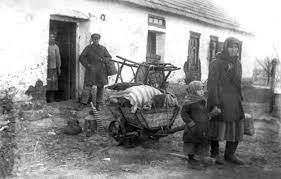Ukraine currently finds itself fighting for its sovereignty in the face of a lawless Russian invasion. Thousands of innocent lives have been lost in this brutal war, and the end is nowhere near in sight. Though many were surprised by the eventuality of war, Ukraine and Russia’s complex history has pointed toward it for the longest time.
Ukraine and Russia trace their history to the Kievan Rus’, a confederation of East Slavic, Baltic, and Finnic people that existed from the 9th to the 13th century. Kyiv, the capital of Ukraine, is also the historical capital of Kievan Rus’ and its significance to both Ukraine and Russia is only the beginning of the complicated relationship between these two countries. While Kievan Rus’ experienced prosperity during this time period, that all came to an end in the 13th century when the Mongol Golden Horde attacked. As a consequence, Ukraine became a part of the Grand Duchy of Lithuania while the Grand Duchy of Moscow began to rise.
It was only when the Cossack Hetmanate was founded in the 17th century that a semblance of a unified Ukrainian state began to exist once again. The Ukrainian Cossack state strived to be independent, fighting battles against both the Polish-Lithuanian Commonwealth and Moscow. However, by the 18th century the Cossack Hetmanate ceased to exist and Ukraine was incorporated into the Little Russia Governorate. In order to prevent Ukraine from seceding, Russia banned the teaching of the Ukrainian language in schools at the start of the 19th century. By the late 19th century, publication of literature and delivery of lectures in the Ukrainian language was prohibited as well. Despite the oppression, the will of the Ukrainian people to be independent remained strong, resulting in the birth of the Ukrainian People’s Republic (UPR) in 1917.
The opportunity for Ukrainian independence came at the heels of World War I (WWI) when Vladimir Lenin and the Bolsheviks, with aid from the minority movements, brought down the tsarist regime. In an attempt to gain votes and seize control of the Russian Republic, the Bolsheviks pandered to the Ukrainian movement for independence. They, however, went back on their word, deciding that Ukrainian autonomy would be harmful to the Russian empire. Lenin threatened war, but the Central Rada, the leadership of the UPR, stood their ground. The Bolsheviks responded by establishing the Ukrainian Socialist Republic (USR), which they claimed was the legitimate government of Ukraine. Knowing that a war between the UPR and Bolsheviks was imminent, the Central Powers of WWI struck a deal with the UPR: in exchange for grain, among other things, the Central Powers pushed the Bolsheviks out of major Ukrainian cities. For a brief moment, Ukraine became a puppet state of the Central Powers, but the UPR was able to regain control after the Central Powers lost WWI.
Even after WWI ended, the soils of Ukraine remained tumultuous. The Russian Civil War reached the territories of Ukraine and both the Red Army and White Army wreaked havoc. Ultimately, the Red Army conquered the territory, but the Ukrainians wishing for independence rejected their rule. Lenin tried to appease the Ukrainian public by allowing expression of their national identity and giving the illusion of choice to secede from Russia. Stalin, on the other hand, did not want to risk losing valuable resources from Ukraine’s fertile land. His government brought about cultural repression and sowed distrust of the Ukrainian people to non-Ukrainian Soviet citizens for their attempts to establish independence with the UPR. Stalin’s crimes towards the Ukrainian people culminated in the Holodomor, a state-sponsored genocide that led to an estimated 5 million deaths.

Despite their suffering under the Union of Soviet Socialist Republics (USSR), Ukraine’s political status remained unchanged until Germany turned against its ally, the Soviet Union, and invaded Ukraine and Russia during World War II. With the promise of independence from Russia, Ukrainian nationalists sided with Nazi Germany, but that promise was promptly broken once Germany took control of Ukraine. Nazi Germany’s reign over Ukraine lasted over three years until the USSR regained control, and Ukraine remained a member until 1991. It was during this time period that Crimea was transferred from Soviet Russia to Soviet Ukraine. By 1991, after the USSR collapsed, Ukraine became the modern independent state we now know.
Throughout their intertwined history over a thousand years, Ukraine has voiced nothing but desire to become an independent state with guaranteed equality and human rights. Yet even when Ukraine gained independence, Russia has refused to respect that. In Putin’s eyes, today’s invasion of Ukraine by Russia is justified. He only sees Ukraine as a limb of the Soviet Union that must be “saved”, whether it’s from the influences of Western imperialism or the remnants of Nazis from WWII. The annexation of Crimea in 2014 after former Ukrainian president Viktor Yanukovych’s ouster is one of many examples of Russia overstepping its boundaries. Russia has no right to interfere with Ukraine — as a sovereign state, Ukraine has the right to resolve its matters in whichever way it sees fit.

